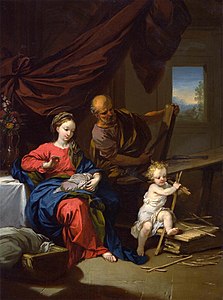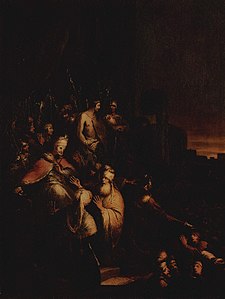Christian Wilhelm Ernst Dietrich
Christian Wilhelm Ernst Dietrich | |
|---|---|
 C. W. E. Dietrich (1767); portrait by Anton Graff | |
| Born | October 30, 1712 |
| Died | April 23, 1774 (aged 61) |
This article includes a list of general references, but it lacks sufficient corresponding inline citations. (May 2013) |
Christian Wilhelm Ernst Dietrich (30 October 1712 – 23 April 1774) was a German painter and art administrator. In his own works, he was adept at imitating many earlier artists, but never developed a style of his own.
Early life
[edit]
Dietrich was born at Weimar, where he was brought up early to the profession of art by his father Johann Georg, then painter of miniatures to the court of the duke.[1] Dietrich's sister was painter Maria Dorothea Dietrich.[2]
Career
[edit]Dietrich was sent to Dresden to perfect himself under the care of Johann Alexander Thiele. At the age of eighteen he finished a painting in two hours, which attracted the attention of the king of Saxony,Augustus II. He was so pleased with Dietrich's work that he gave him means to study abroad, and visit the chief cities of Italy and the Netherlands. There he learned to copy and to imitate masters of the previous century with a versatility that was truly surprising. Johann Joachim Winckelmann, to whom he had been recommended, called him the Raphael of landscape. His landscapes were frequently based on the works of Salvator Rosa and Allaert van Everdingen.[1]
He was also successful in aping the style of Rembrandt, and numerous examples of this habit may he found in the galleries of St. Petersburg, Vienna and Dresden. At Dresden there are pictures acknowledged to be his, bearing the fictitious dates of 1636 and 1638, and the name of Rembrandt. Among Dietrich's reproductions of Ostade's manner is the Itinerant Singers at the National Gallery. Dietrich tried every branch of art except portraits, painting Italian and Dutch views alternately with scripture scenes and still life.[1] He also created multiple engravings, a collection of which are at the British Museum and are inspired by Ostade and Rembrandt.
In 1741 he was appointed court painter to Augustus III at Dresden, with an annual salary of 400 thalers, conditional on the production of four cabinet pictures a year. This condition likely accounts for the presence of fifty-two of the master's panels and canvases in one of the rooms at the Dresden museum.[1] In 1746, he was appointed inspector of galleries.[citation needed]
Dietrich, though popular and probably the busiest artist of his time, never produced anything of his own.
Dietrich, after his return from the Peninsula, generally signed himself Dieterich, and with this signature most of his extant pictures are inscribed.[1]
Later years and death
[edit]He died at Dresden, after he had successively filled the important appointments of director of the school of painting at the Meissen porcelain factory (appointed 1763) and professor of the Dresden Academy of Art (appointed 1765).[1]
Gallery
[edit]-
The Holy Family in a Carpenter's Shop
-
The Flight into Egypt
-
Christ Before the People
-
Christ's Entombment
-
Haberdasher
-
The Wandering Musicians
-
concert champetre 1737" oil on canvas
Notes
[edit]- ^ a b c d e f Chisholm 1911.
- ^ "Old Master Paintings - Maria Dorothea Wagner - Dorotheum". Dorotheum. Retrieved 9 December 2018.
References
[edit]- Gilman, D. C.; Peck, H. T.; Colby, F. M., eds. (1905). . New International Encyclopedia (1st ed.). New York: Dodd, Mead.
- Rines, George Edwin, ed. (1920). . Encyclopedia Americana.
Attribution:
- This article incorporates text from a publication now in the public domain: Chisholm, Hugh, ed. (1911). "Dietrich, Christian Wilhelm Ernst". Encyclopædia Britannica. Vol. 8 (11th ed.). Cambridge University Press. p. 221.
External links
[edit] Media related to Christian Wilhelm Ernst Dietrich at Wikimedia Commons
Media related to Christian Wilhelm Ernst Dietrich at Wikimedia Commons







